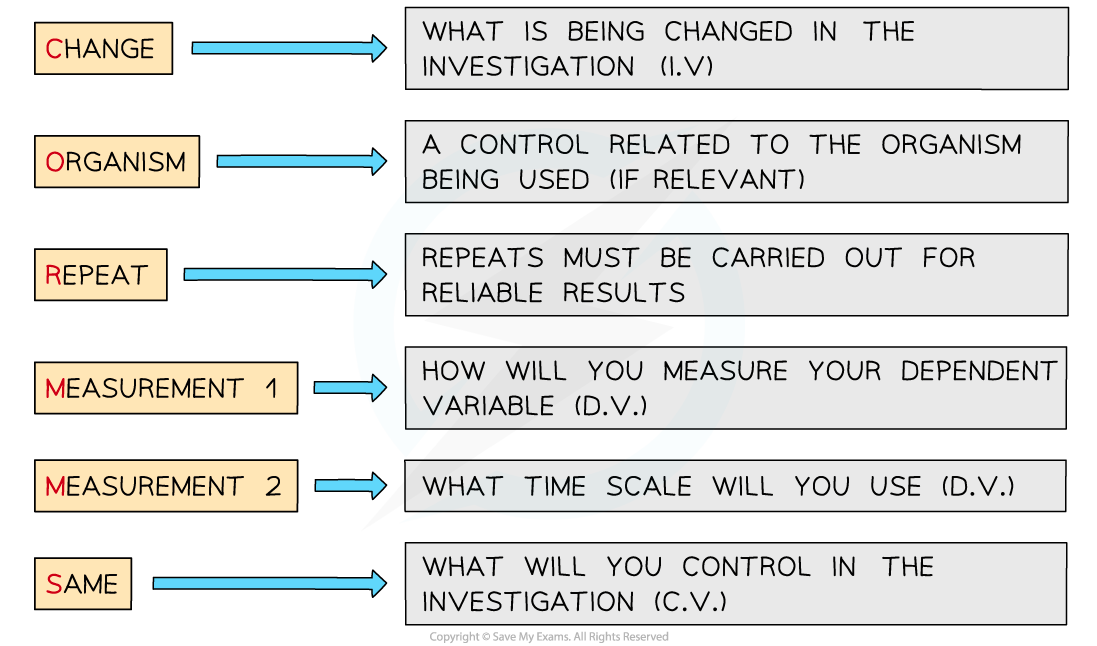Did this video help you?
Practical: Investigating Light & Photosynthesis (Edexcel GCSE Biology: Combined Science)
Revision Note
Practical: Investigating Light & Photosynthesis
- Investigations to determine the effects of light intensity, carbon dioxide concentration and temperature on the rate of photosynthesis can be carried out using aquatic plants, such as Elodea or Cabomba (types of pondweed)
- The effect of these limiting factors on the rate of photosynthesis can be investigated in the following ways:
- Light intensity – change the distance (d) of a light source from the plant (light intensity is proportional to 1/d2)
- Carbon dioxide concentration – add different quantities of sodium hydrogencarbonate (NaHCO3) to the water surrounding the plant, this dissolves to produce CO2
- Temperature (of the solution surrounding the plant) – place the boiling tube containing the submerged plant in water baths of different temperatures
- Whilst changing one of these factors during the investigation (as described below), ensure the other two remain constant
- For example, when investigating the effect of light intensity on the rate of photosynthesis, a glass tank should be placed in between the lamp and the boiling tube containing the pondweed to absorb heat from the lamp – this prevents the solution surrounding the plant from changing temperature
Apparatus
- Beaker
- Scalpel
- Pondweed
- Boiling tube
- Boiling tube bung
- Solution of water and sodium hydrogencarbonate
- Water bath
- Light source
- Ruler
- Prongs
- Gas syringe
- Thermometer

The set up of the experiment to measure the rate of photosynthesis of an aquatic plant (pondweed) by measuring the rate of oxygen gas produced. All three limiting factors can be assessed this way
Method
- Step 1: Ensure the water is well aerated before use by bubbling air through it
- This will ensure oxygen gas given off by the plant during the investigation form bubbles and do not dissolve in the water
- Step 2: Ensure the plant has been well illuminated before use
- This will ensure that the plant contains all the enzymes required for photosynthesis and that any changes of rate are due to the independent variable
- Step 3: Set up the apparatus in a darkened room
- Ensure the pondweed is submerged in sodium hydrogencarbonate solution (1%) – this ensures the pondweed has a controlled supply of carbon dioxide (a reactant in photosynthesis)
- Step 4: Cut the stem of the pondweed cleanly just before placing into the boiling tube
- Step 5: Measure the volume of gas collected in the gas-syringe in a set period of time (eg. 5 minutes)
- Step 6: Change the independent variable - move the light source closer and repeat step 5
- Step 7: Record the results in a table and plot a graph of volume of oxygen produced per minute against the distance from the lamp
Results and analysis
- Initially, as the distance from the light source decreases, the volume of oxygen produced increases
- This is because as the light intensity increases, the rate of photosynthesis increases
- At a certain point, light is no longer the limiting factor and so an increase in light intensity (decrease in the distance) will not result in an increase in photosynthesis
- Another factor is limiting the rate of photosynthesis e.g. carbon dioxide concentration
- In this experiment, care needs to be taken to ensure that the temperature is not affected as the light source moves closer
Applying CORMS evaluation to practical work
- When working with practical investigations, remember to consider your CORMS evaluation

CORMS evaluation
- In this investigation, your evaluation should look something like this:
- C - We are changing the distance of the light source from the pondweed
- O - The same plant or same species, age/size of plant is used
- R - We will repeat the investigation several times to ensure our results are reliable
- M1 - We will observe the volume of oxygen produced
- M2 - ...after a given time
- S - We will control the temperature of the room and carbon dioxide concentration

You've read 0 of your 5 free revision notes this week
Sign up now. It’s free!
Did this page help you?
